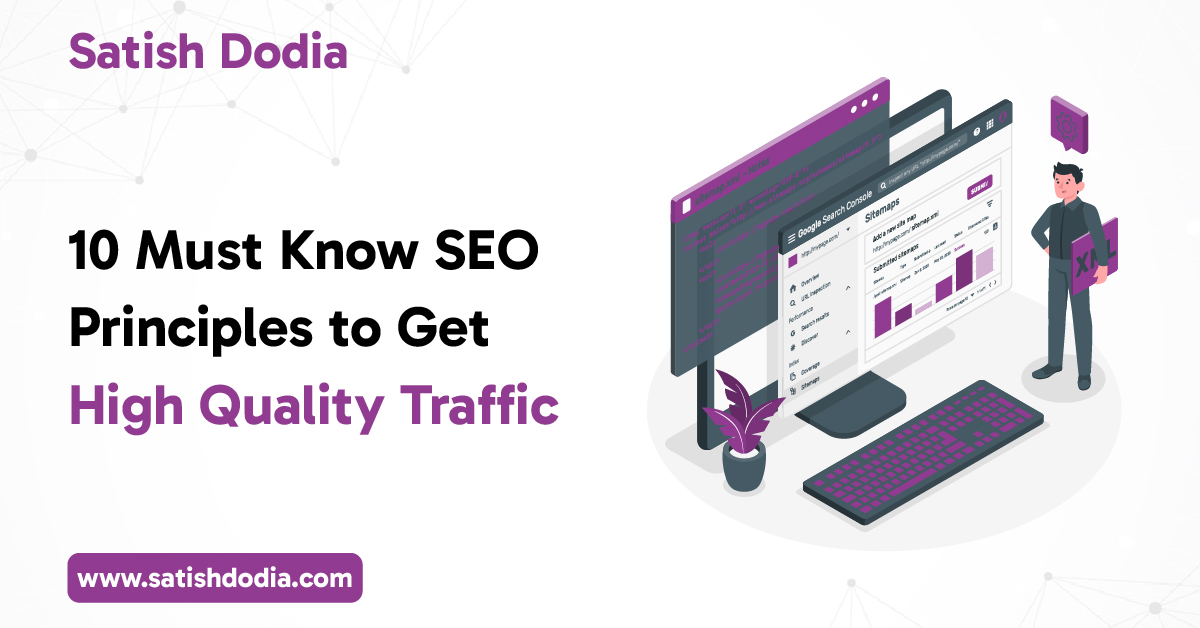Getting high-quality traffic isn’t just about ranking on page one—it’s about ranking right and attracting the right users. Google has become smarter with updates like Helpful Content, Core Web Vitals, and AI Overviews. If your content doesn’t meet their expectations, your rankings will slide.
In this blog, we break down 10 essential SEO principles every marketer, entrepreneur, or business owner should follow. These are based on proven strategies and real-world experience, including insights from SEO expert Satish Dodia.
1. Write for Humans First, Then Google
The days of keyword-stuffing are over. Google now uses semantic search to understand intent.
- Use natural language
- Avoid robotic or forced keywords
- Add real examples or use cases
LSI Keywords: user intent, content quality, helpful content
2. Perform Smart Keyword Research
Keyword research still matters—but not just search volume. You need:
- Low-competition, high-intent keywords
- Long-tail variations
- Questions people ask (like on Google or Reddit)
Tools to use: Google Keyword Planner, Ubersuggest, AnswerThePublic
LSI Keywords: keyword tools, keyword difficulty, intent-based search
3. Prioritize Topical Authority
Don’t create random blogs. Build topical clusters around your niche.
Example: If your site is about SEO, create posts on:
- On-page SEO
- Technical SEO
- Local SEO
- Link building
- SEO audits
Link them internally to show search engines you cover the topic in-depth.
LSI Keywords: topical relevance, internal linking, content hubs
4. Nail Your On-Page SEO
Make every page easy to read, crawl, and rank. Here’s your on-page checklist:
- Title tag under 60 characters
- Meta description under 160 characters
- H1-H3 headers with main and LSI keywords
- Optimized images with descriptive alt text
- Clear URLs with target keywords
LSI Keywords: heading structure, alt text, SEO title
5. Focus on Page Speed & Core Web Vitals
Google wants your site fast. Slow sites don’t rank well and users bounce quickly.
Quick wins:
- Use WebP image formats
- Minify CSS/JS
- Use lazy loading
- Choose a fast host (like LiteSpeed or Cloudflare CDN)
LSI Keywords: mobile speed, page load time, web vitals
6. E-E-A-T: Show You’re Trustworthy
E-E-A-T stands for Experience, Expertise, Authoritativeness, and Trust.
If Google doesn’t trust your site, it won’t rank you well.
Show this by:
- Adding author bios (like Satish Dodia)
- Citing sources
- Getting backlinks from respected sites
LSI Keywords: trust signals, authority backlinks, credible sources
7. Use Structured Data (Schema Markup)
Structured data helps Google understand your content. Use schema for:
- Articles
- FAQs
- Reviews
- Products
- Local business info
Add schema using JSON-LD via tools like Schema.org or RankMath.
LSI Keywords: rich snippets, schema generator, FAQ schema
8. Optimize for Mobile Experience
Over 60% of traffic is mobile. Your website must be:
- Fully responsive
- Tap-friendly
- Fast on 3G networks
- Clear and easy to navigate
LSI Keywords: mobile-friendly SEO, responsive design, user experience
9. Build Backlinks Naturally
Links still matter. But avoid spammy exchanges.
To earn backlinks:
- Publish quality blog content
- Use HARO to pitch journalists
- Create infographics or stats others will link to
LSI Keywords: link building, outreach, white-hat backlinks
10. Keep Monitoring, Testing & Updating
SEO is not set-and-forget.
Use tools like:
- Google Search Console
- Ahrefs / SEMrush
- Hotjar (to understand user behavior)
Update content regularly—especially pages that drop in rankings.
LSI Keywords: SEO audits, content refresh, ranking loss
Bonus Tips by Satish Dodia
Satish Dodia, with years of real-world SEO practice, suggests:
- Don’t chase trends blindly. Stick to what works—solid content, speed, and intent.
- Don’t rely on AI only. Human editing and expertise are key to build trust.
- Use multimedia. Add images, videos, and infographics to hold attention.
Frequently Asked Questions
Q1: How do I get traffic faster from Google?
Focus on long-tail, low-competition keywords, fast-loading pages, and topical relevance. Make sure to submit your sitemap in Google Search Console.
Q2: What is semantic SEO and why does it matter?
Semantic SEO is about writing content that answers intent—not just keywords. It helps Google understand the context and rank you better.
Q3: How long does it take to rank a blog?
It depends on domain age, content quality, and backlinks. But with fresh, optimized content, indexing can happen within 24–48 hours.
